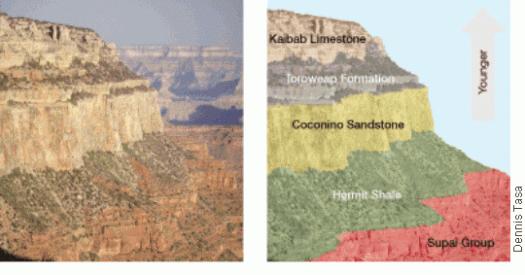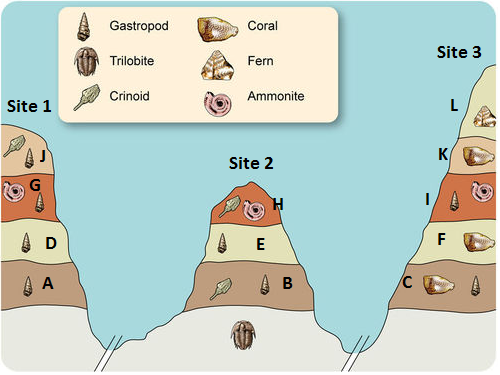Relative Age Of Rocks

- 1.
According to the Law of Superposition, in horizontal sedimentary rock layers, the oldest rocks are found _______________.
- A.
In the middle
- B.
At the top
- C.
At the bottom
- D.
In a diagonal
Correct Answer
C. At the bottomExplanation
According to the Law of Superposition, in horizontal sedimentary rock layers, the oldest rocks are found at the bottom. This is because new layers of sediment are deposited on top of older layers over time, causing the older layers to be found deeper in the rock sequence. As a result, the bottommost layers are the oldest, while the topmost layers are the youngest.Rate this question:
-
- 2.
An unconformity is caused by _________________.
- A.
Erosion
- B.
Isotopes
- C.
Precambrian
- D.
Faults
Correct Answer
A. ErosionExplanation
An unconformity is a gap in the geological record where there is missing or incomplete information about the rock layers. This gap is caused by erosion, which is the process of wearing away or removing the rock layers. Over time, weathering and other natural forces can erode the exposed rock surfaces, leading to the formation of an unconformity. This erosion can remove the evidence of past rock layers and geological events, creating a gap in the geological record.Rate this question:
-
- 3.
________________ says that the geologic processes that shaped Earth's surface in the past continue to shape Earth's surface today.
- A.
Intrusion
- B.
Extrusion
- C.
Unconformities
- D.
Uniformitarianism
Correct Answer
D. UniformitarianismExplanation
Uniformitarianism is the correct answer because it states that the geologic processes that occurred in the past are still occurring today and are responsible for shaping Earth's surface. This principle suggests that the same natural laws and processes that operated in the past are still operating in the present, allowing scientists to study and understand Earth's history by observing and studying its current processes. This concept is fundamental to the field of geology and helps explain the gradual changes that have occurred on Earth over millions of years.Rate this question:
-
- 4.
_____________ fossils were widely distributed and lived a short period of time. They can be used to determine the relative age of rocks.
- A.
Trace
- B.
Mold
- C.
Cast
- D.
Index
Correct Answer
D. IndexExplanation
Index fossils are widely distributed and lived for a short period of time. These fossils are used to determine the relative age of rocks because they are found in specific layers of sedimentary rocks and can be used to correlate the ages of different rock formations. By studying the presence of index fossils in different rock layers, scientists can establish a relative timeline of when these organisms existed and use it to date the surrounding rocks.Rate this question:
-
- 5.
Geologists study the ___________ age of __________ rocks in order to help them learn more about the relative age of sedimentary rocks.
- A.
Absolute; igneous
- B.
Absolute; metamorphic
- C.
Relative; sedimentary
- D.
Relative; metamorphic
Correct Answer
A. Absolute; igneousExplanation
Geologists study the absolute age of igneous rocks in order to help them learn more about the relative age of sedimentary rocks. This is because igneous rocks are formed from the cooling and solidification of molten material, which allows geologists to determine their exact age using radiometric dating techniques. By comparing the absolute age of igneous rocks to the relative age of sedimentary rocks, geologists can establish the sequence of events and understand the geological history of an area.Rate this question:
-
- 6.
According to the Law of Superposition, which layer in this image is the youngest?
- A.
Hermit shale
- B.
Toroweap Formation
- C.
Kaibab Limestone
- D.
Coconino Sandstone
Correct Answer
C. Kaibab LimestoneExplanation
The Law of Superposition states that in an undisturbed sequence of rock layers, the youngest layer is on top and the oldest is at the bottom. In the given image, the Kaibab Limestone layer is located above the Hermit shale, Toroweap Formation, and Coconino Sandstone layers. Therefore, the Kaibab Limestone layer is the youngest layer in the image.Rate this question:
-
- 7.
Which layer at Site 2 is the same age as Layer D, from Site 1?
- A.
Layer K
- B.
Layer I
- C.
Layer E
- D.
Layer A
Correct Answer
C. Layer EExplanation
Layer E is the same age as Layer D from Site 1.Rate this question:
-
- 8.
An intrusion is always ______________ than the rock it cuts through.
- A.
Different
- B.
Older
- C.
Younger
Correct Answer
C. YoungerExplanation
An intrusion refers to a body of igneous rock that has forcefully entered and cut through pre-existing rocks. Since the intrusion is formed after the rocks it cuts through, it is logically younger than the rocks it intrudes upon. Therefore, the correct answer is "younger."Rate this question:
-
Quiz Review Timeline +
Our quizzes are rigorously reviewed, monitored and continuously updated by our expert board to maintain accuracy, relevance, and timeliness.
-
Current Version
-
Mar 21, 2023Quiz Edited by
ProProfs Editorial Team -
Apr 14, 2018Quiz Created by
Bsowens
 Back to top
Back to top




